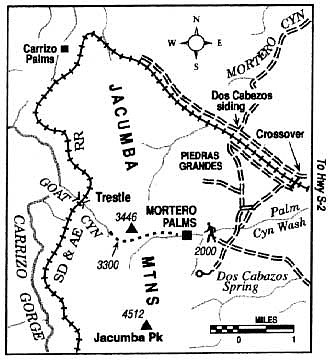 Facebook
Facebook
 X
X
 Instagram
Instagram
 TikTok
TikTok
 Youtube
Youtube
As temperatures cool in the desert east of San Diego, campers and hikers are again fanning out over the spacious 1000 square miles of territory in Anza-Borrego Desert State Park. If it's solitude you're looking for (at least until the late-winter wildflower season kicks in), try visiting the southernmost area of the park -- just north of Interstate 8, less than two hours east of San Diego by car. Mortero Palms, with heaps of huge boulders and a huddle of palm trees, is one good destination in the area.
Thanks to Anza-Borrego's open-camping policy, you can car camp, or carry your overnight gear as near or as far from any paved or dirt road as you like, and commune with nature -- without having to deal with reservations or fees. (Just remember that any campfire must be in a container off the ground, and you can't burn any of the local vegetation.)
To get to Mortero Palms, drive east (from San Diego) on I-8 to Ocotillo, and take Highway S-2 4 miles north and west to an unsigned dirt road on the left. Go south on this road and swing right after 1.1 miles. Continue west for another 4.6 miles, and turn left across the disused San Diego & Arizona Eastern railroad tracks on a paved crossover. Continue another 0.1 mile, then veer left, away from the tracks. Go another 1.6 miles, staying left at the next two junctions, and then go right toward the Mortero Palms roadend. (To check on the condition of these dirt roads, which might require high clearance or four-wheel drive, call Anza-Borrego Desert State Park at 760-767-5311 or 760-767-4205).
The palms themselves lie in a wide canyon about a half-mile west (not south) of the roadend. Look for bedrock morteros, or Indian grinding holes, below the first few palms.
If and only if you're an accomplished, well-prepared desert hiker ready for at least three hours of scrambling round trip, you can climb past the palm grove and navigate through gauntlets of cholla cactus to reach a 3300-foot saddle in the Jacumba Mountains above. From there, you can head west (downhill) into Goat Canyon, where you can spy from a distance the famous 200-foot-high wooden trestle on the old San Diego & Arizona Eastern rail line.


As temperatures cool in the desert east of San Diego, campers and hikers are again fanning out over the spacious 1000 square miles of territory in Anza-Borrego Desert State Park. If it's solitude you're looking for (at least until the late-winter wildflower season kicks in), try visiting the southernmost area of the park -- just north of Interstate 8, less than two hours east of San Diego by car. Mortero Palms, with heaps of huge boulders and a huddle of palm trees, is one good destination in the area.
Thanks to Anza-Borrego's open-camping policy, you can car camp, or carry your overnight gear as near or as far from any paved or dirt road as you like, and commune with nature -- without having to deal with reservations or fees. (Just remember that any campfire must be in a container off the ground, and you can't burn any of the local vegetation.)
To get to Mortero Palms, drive east (from San Diego) on I-8 to Ocotillo, and take Highway S-2 4 miles north and west to an unsigned dirt road on the left. Go south on this road and swing right after 1.1 miles. Continue west for another 4.6 miles, and turn left across the disused San Diego & Arizona Eastern railroad tracks on a paved crossover. Continue another 0.1 mile, then veer left, away from the tracks. Go another 1.6 miles, staying left at the next two junctions, and then go right toward the Mortero Palms roadend. (To check on the condition of these dirt roads, which might require high clearance or four-wheel drive, call Anza-Borrego Desert State Park at 760-767-5311 or 760-767-4205).
The palms themselves lie in a wide canyon about a half-mile west (not south) of the roadend. Look for bedrock morteros, or Indian grinding holes, below the first few palms.
If and only if you're an accomplished, well-prepared desert hiker ready for at least three hours of scrambling round trip, you can climb past the palm grove and navigate through gauntlets of cholla cactus to reach a 3300-foot saddle in the Jacumba Mountains above. From there, you can head west (downhill) into Goat Canyon, where you can spy from a distance the famous 200-foot-high wooden trestle on the old San Diego & Arizona Eastern rail line.
